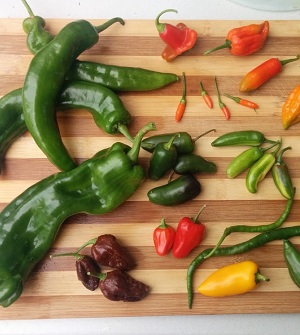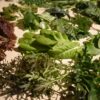From bell peppers to Carolina reapers – there’s a capsicum taste sensation to suit every level of heat tolerance, and they come in such an array of beautiful shapes, colours and sizes too, easily making them collector’s plants. Chillies remain one of my best sellers, and one of my most often requested topics for talks.
I am myself, an absolute chilli-head, I love growing a range of different chillies, and I love using them in my food (and medicine!) too. My passion for these peppers has come a long way – and my experience in growing them and using them still expands year-on-year. Here’s a few notes that I hope will inspire you to try to grow some of your own in your garden this year.
A bit of Botany
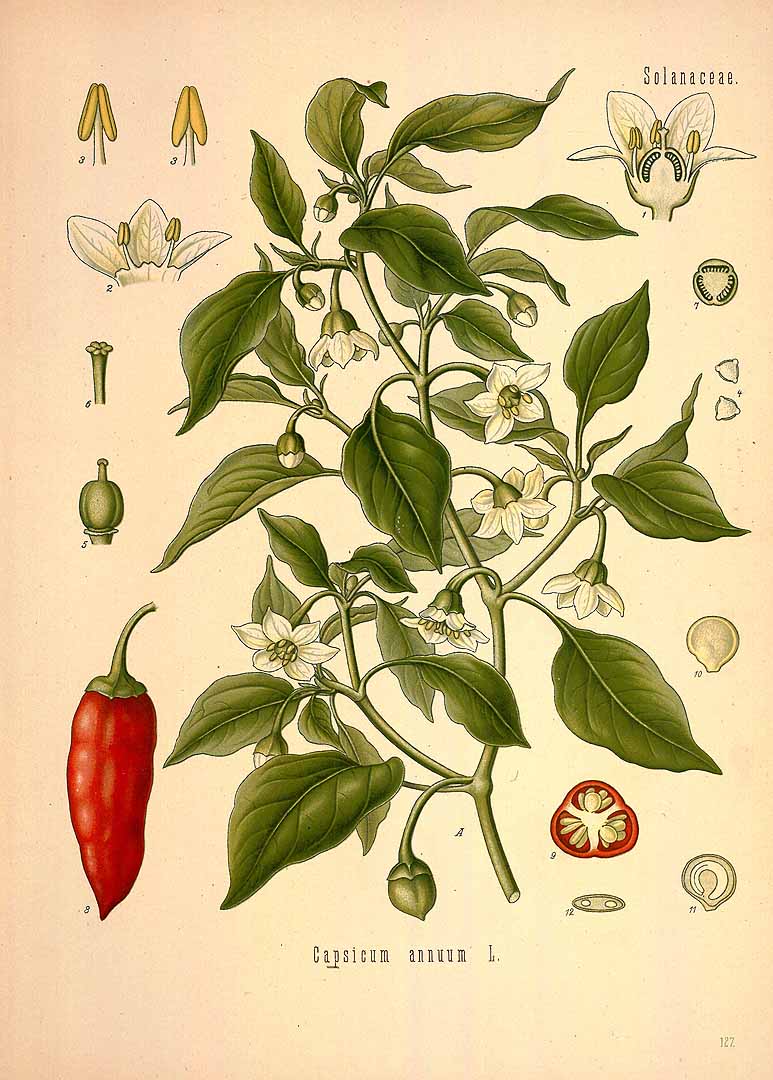
The genus Capsicum gets its name from the Greek kapto which means “I bite”. Capsicums belong to Solanaceae (nightshade) family which include plants such as tomatoes, eggplants and potatoes.
They are generally accepted to be perennials that are often grown as annuals in temperate to cool climates, but they can successfully be overwintered in the right environments.
Most chilli plants are small (<1) and bushy with many branches. They have dark green ovate leaves, small white or purple star-shaped flowers, and then of course, their many-seeded fruit pods, the chillies, that are so sought after.
There’s around 27 species of capsicum, but only 5 are generally domesticated:
- Capsicum annuum, e.g. bell peppers, wax peppers, cayenne and jalapenos
- Capsicum frutescens, e.g. tabasco, Thai, piri-piri and Kambuzi
- Capsicum chinense, e.g. naga, habanero, Scotch bonnet and Datil
- Capsicum pubescens, e.g. rocoto peppers
- Capsicum baccatum, e.g. aji peppers
Sowing
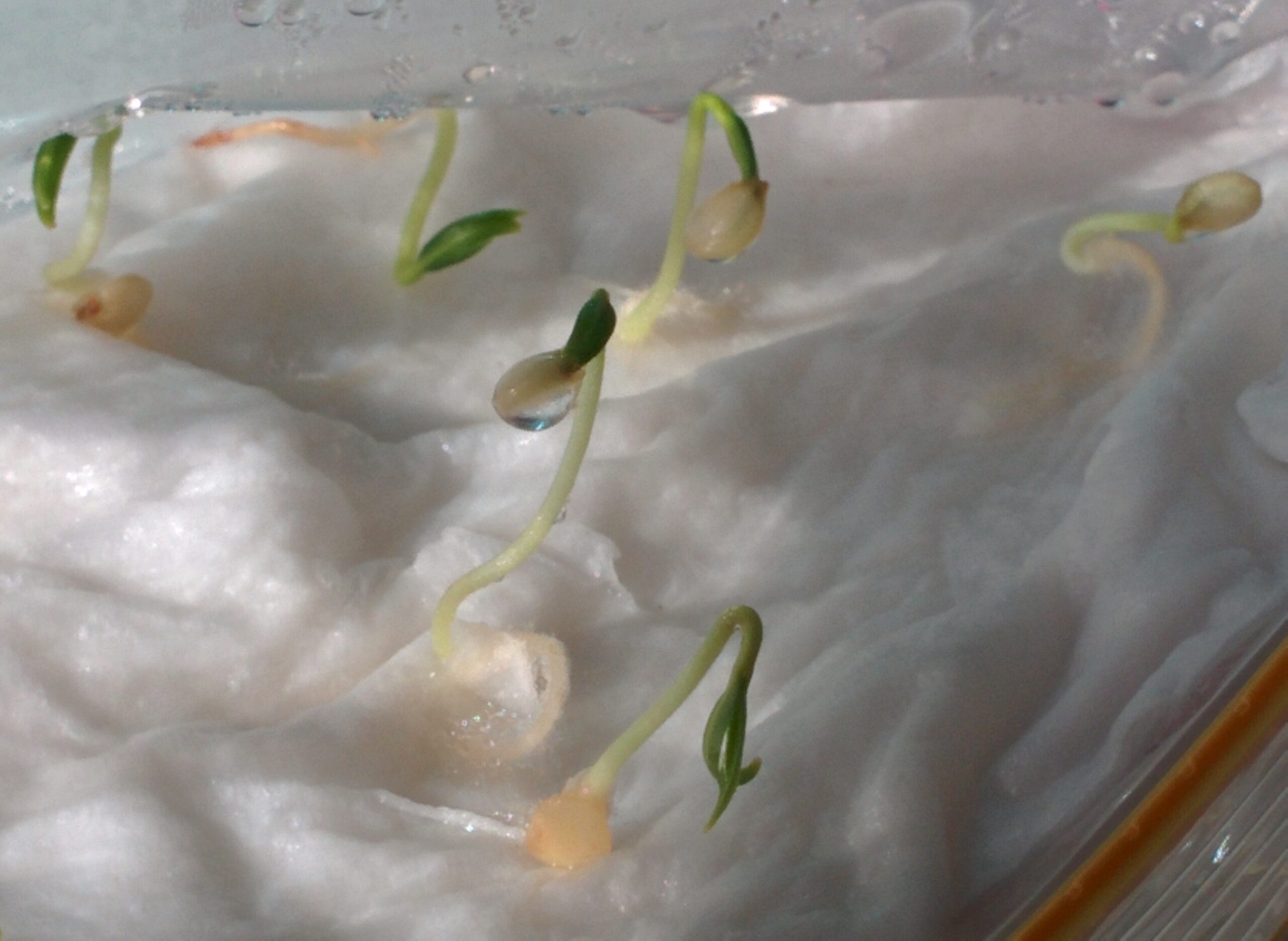
Heat
There is but one rule for growing chillies from seed, and that is consistent heat. Whether you soak your seeds beforehand, or not, and what you use to soak them with, or whether you sprout them on a tissue paper or in seed raising mix, the most important starting point is to ensure that the seed stays at a temperature of above 20C (preferably 23C-28C).
You can create this heat by various means – heated pads for seedling germination is a good choice, albeit a bit expensive. I’ve seen some really interesting contraptions where people homemade their own hot-boxes too. You can also try a warm windowsill, or on top of a hot-water cylinder in the home. Remember your seeds do not need light to germinate, it is
only once they have sprouted that they are going to need to start photosynthesizing.
Water
Of course, as with all seed raising, the medium (soil) should never dry out, so it is important to keep the seed moist at all times. If you can, use a fine mist spray so that you don’t disturb the seed and the soil, but make sure that you don’t just wet the surface, but that the medium is moist through and through.
Patience
Patience is the last requirement, as it sometimes take chilli seeds quite a while to break their dormancy and start germinating. If you are used to salad rocket coming up almost a day after sowing them, or basil that take around a week, having to wait several weeks for your peppers to pop up may seem too long. But trust me, give the seeds a bit more time than you think before discarding – I’ve had some surprise me by germinating a couple of weeks later than I thought they should.
Step-by-step
- You can soak your seed for up to 48 hours, this helps them to break dormancy, and may reduce the time it takes them to come up after sowing, and it may increase your success rate of germination. I have previously soaked seeds in water, and as an experiment soaked them in a weak chamomile tea to see if it made any difference. My results were inconclusive, and an experiment I’d like to try again. You can also create a small nick or scratch in the outer seed coat, this especially works on peppers such as Rocoto. Horticulturally known as scarifying, this technique also help to break seed dormancy. Be very careful not to cut too deep though as this will ruin the seed.
- Wet the seed raising mix thoroughly before sowing the seeds.
- The chilli seed should be sown at a depth of not more than 1.5 times its own size. Oftentimes placing the seed on seed raising mix and covering with another light layer is sufficient.
As a side note – I have, to great success, pre-germinated chilli seeds by placing the soaked seed on a moistened kitchen towel, inside a zip-lock sandwich bag – an alternative to seed raising soil mixes. - Ensure the seed mix does not dry out, and spray with water every few days. You can even spray with warm water (not hot) so that the temperature does not suddenly drop. Check that it is free-draining, you don’t want your seed or seedlings to rot in too much water either…
- Keep the heat level constant.
- Wait.
- Once your seedlings emerge, it is time to move them into a sunny and warm, sheltered spot until they are large enough to prick out and pot on. Seedlings that do not get enough sunlight at this stage tend to grow lanky, long and weak.
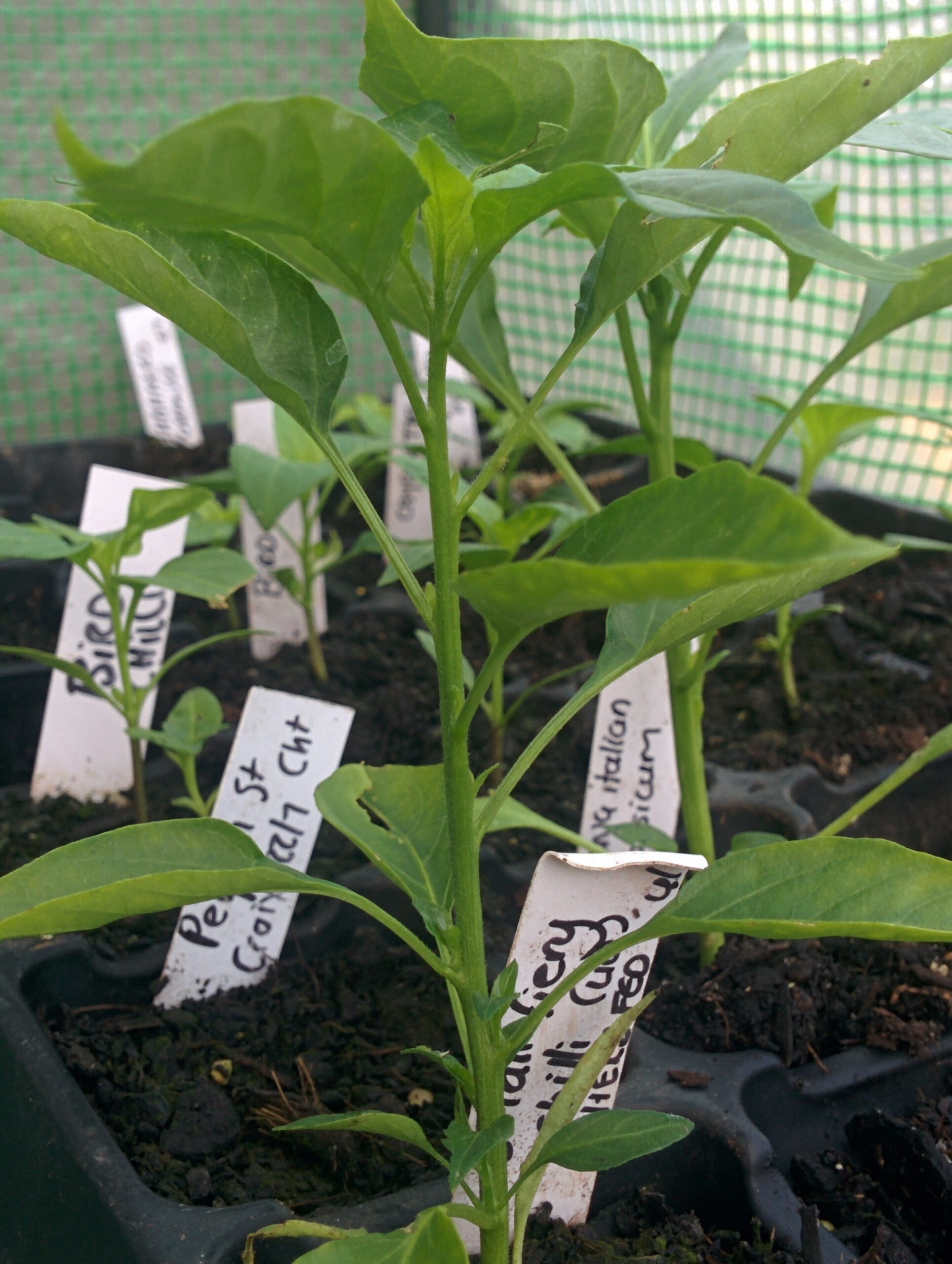
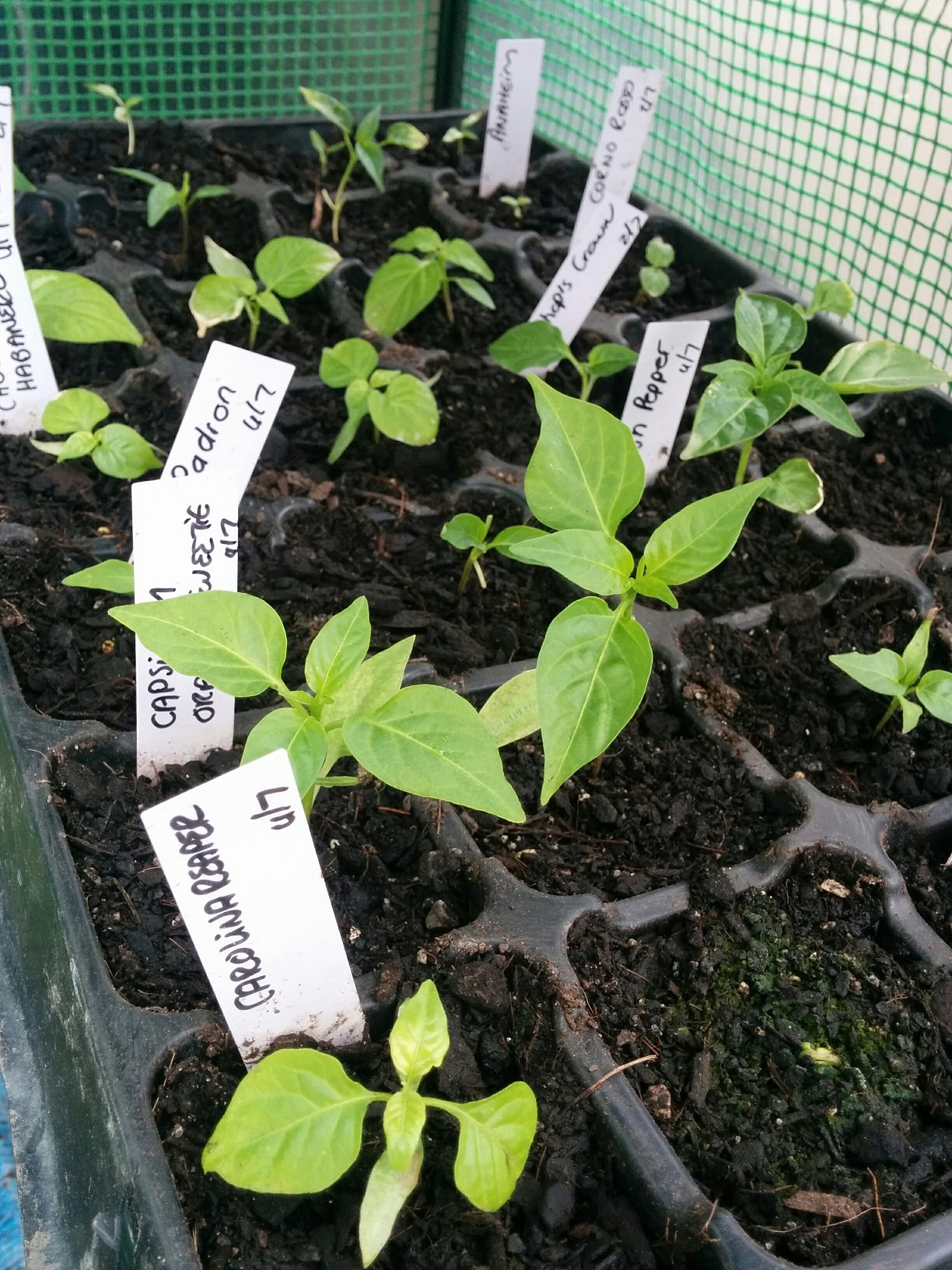
Growing
Once your seedlings are going, it is a matter of potting them on to bigger pots as they grow and need more space, always keeping them warm and sheltered, until eventually your outside temperatures are warm enough to plant them in the ground in your garden. Of course, some chillies make beautiful potted specimens, so you can leave them in a final pot too.
Site
In the garden, they need a warm full sun position that is sheltered from strong winds, and cold snaps. You can stake and tie them up if needed.
Soil
The soil you grow it in should be moderately fertile, moisture retentive, but well-draining. Mixing in some organic compost to your garden soil before planting should be sufficient.
Water
Water deeply once a week (more often if they are in pots)
Feed
Add a good seaweed feed every two weeks. As with tomatoes, they can have some Epsom salts added to help with flowering and fruiting.
Prune
Chillies fruit on side branches, and pruning and topping them off (cutting the growth tip off) will encourage side shoots to form and you will have more fruit.

Pollinate
To ensure a good fruit set, pollination is key. Peppers are actually self-pollinating and while you strictly don’t need bees or other insects to ensure fertilization, the vibration caused by their wings and the movement in and out of the flowers, do help loosen and move the pollen.
In nature, capsicum depend on wind for pollination, but in the home garden, or specifically if you grow in a greenhouse or sheltered spot, you can give your plants some help by tapping and tickling. Tickling your plant simply means that you go with your finger tip, a cotton bud, or a fine paintbrush, and from the inside of one flower spread the pollen to the inside of another flower. Like tickling someone under their armpits. Tapping, a bit less intrusive to the plant, refers to softly tapping, or shaking the plant to mimic wind movement through the branches. You can even use an electric toothbrush’s buzz on various branches to gently shake the flowers so their anthers release the pollen onto their stigma.
Harvest
Chillies are wonderful in the fact that they produce more flowers and fruit as you pick them. I’ve come to generally do an initial harvest of most of the first green chillies on my plants and have been rewarded with more fruit later in the season. Continually harvesting the peppers will see you have a long and productive chilli season.






FAQ
- Q: How do I make my chillies hotter?
A: Well, firstly, choose a cultivar that is renowned for its heat – (I’ll be writing about the Scoville Heat Scale soon). But it is also believed that peppers on a plant *may* intensify their heat levels when they are stressed – in other words, wait until your peppers form, and then either increase the temperature or decrease the water supply to the point of wilting. Scientists have discovered that in hot and dry months already pungent peppers would be more spicy.
It could also help to only pick the fruit when they are aged and matured on the plant as the amount of capsaicin (the chemical that makes chillies hot) increases over time. - Q: The chillies from the seeds I saved from my own plant last season do not look or taste like they did last year?
A: Chillies are fond of cross-pollinating, and if you grow more than one cultivar in close proximity, you may have inadvertently saved seed from a cross. This is true for chillies and sweet bell peppers – even if you only grow one type of sweet bell pepper and one type of hot chilli, they can cross, meaning the seeds saved from either’s fruit will result in a type of pepper that is neither your sweet one or your hot one.
Or, if you started off with seeds that were from an F1 hybrid, or an unstable hybrid cross, saving the seeds from those would not necessarily result in the same fruit again, but may revert back to either of the original parents that created the hybrid cross. - Q: Some chillies on the same plant are more pungent than others – why?
A: As with my answer to question 1 – the longer a chilli pod stays on the plant, the higher the concentration of capsaicin and the hotter it gets. Perhaps there is simply a difference in maturity of the fruit that you have picked. There is a very fun hot capsicum that I grow called Padron – it generally has mild to medium fruit, but is renowned to have one or two really hot peppers on the plant. Sort of like a Russian Roulette pepper!

